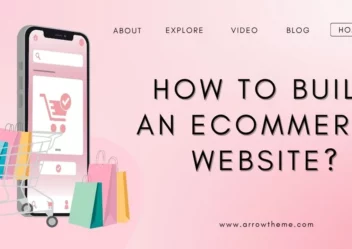6 Types of Ecommerce Business Models & Ecommerce Websites
If you’re planning to launch an online store, understanding the different types of ecommerce business models and ecommerce websites is the first step to long-term success. Not all online stores are built the same. Choosing the right business model can be the difference between just getting by and scaling into a thriving brand.
Come with us to break down the most popular ecommerce business models and explore the types of ecommerce websites that power them. So you can find the right path for your online success.
Claue – Clean and Minimal Magento Theme
We provide an amazing Magento theme with fast and responsive designs. Let’s find out!
What Is an E-Commerce Business Model?
An e-commerce business model is the strategy behind how your online store operates and makes money. Your e-commerce store sells products or services online, but how you choose to sell them, who you sell to, and how you get your products to your customers all depend on the business model you follow.
The model you choose impacts everything: website design, marketing strategy, supply chain, customer support. So, when you’re building an e-commerce store, remember that you are also building a system that matches your business goals and customer needs.
Why Choosing the Right E-Commerce Business Model Matters?

Choosing the e-commerce business model as the foundation for everything else: how you price your products, who you market to, how you fulfill orders, and even how much profit you’ll make.
The Right E-Commerce Business Model Shapes Your Entire Strategy
Your business model specifies how you deliver value and how you make money. Each model comes with its own set of requirements. A B2B wholesale business will need completely different marketing, logistics, and pricing strategies than a D2C skincare brand.
A study by McKinsey found that companies aligned around a clear business model were 3x more likely to achieve long-term growth.
Model Impacts Costs and Profit Margins
Some models, like dropshipping, have low upfront costs but thinner profit margins. Others, like private labeling or owning your own inventory need more investment but have better control and higher margins.
According to Shopify, private label brands can earn 35–50% profit margins, while dropshipping models average closer to 10–20%.
Picking the wrong model can lead to cash flow issues or unsustainable operations.
E-Commerce Business Model Determines Your Customer Experience
The model you choose affects everything your customer sees and feels. 86% of buyers are willing to pay more for a better customer experience (PwC), and your model plays a big role in delivering that.
Influences Your Tech Stack and Operations
Do you need warehousing software? Automated shipping tools? A custom app for subscriptions? Your e-commerce model determines the tech tools and platforms you’ll need to integrate.
E-Commerce Business Model Affects Scalability
Some models scale faster than others. Digital product stores or marketplaces can grow globally without worrying about inventory. In contrast, physical product businesses must manage manufacturing, warehousing, and shipping as they expand.
E-commerce businesses that choose the right model from the start are 60% more likely to scale sustainably within 3 years (BigCommerce data).
What Is An E-Commerce Website?
An e-commerce website is a type of website where businesses or individuals sell products and services online. It works just like a traditional store, but everything happens on the internet. Customers can browse through product pages, add items to their cart, make payments securely, and have their orders delivered – all without stepping outside their homes.
What sets an e-commerce website apart from a regular website is that it’s built with tools designed for online selling. These include shopping carts, payment gateways, product catalogs, order tracking, and customer account systems. When you shop on Amazon or a brand’s Shopify store, you’re interacting with a fully functioning e-commerce platform designed to handle inventory, payments, and shipping.
E-commerce websites are open 24/7, so businesses have the ability to reach customers at any time. This is also the way for a global reach, meaning you can sell your products across different countries without having a physical location there. Over 2.7 billion people shopped online in 2024, and e-commerce now accounts for nearly 22% of all retail sales worldwide.
Most e-commerce websites are powered by popular platforms like Shopify, WooCommerce, Magento, or BigCommerce. HTML, CSS, JavaScript, and databases power the design and functionality. SSL certificates and encrypted gateways ensure data security.
What are the 6 Types of Ecommerce Business Models?
Ecommerce isn’t one-size-fits-all. Depending on who is buying and selling, businesses can follow different ecommerce business models to reach their customers.
B2C (Business-to-Consumer)

B2C (Business-to-Consumer) is where a business sells products or services directly to individual customers. It is the model most people are familiar with when they shop online. For example, when you buy a pair of shoes from Nike’s website or order a phone case from Amazon, you’re part of a B2C transaction. It provides a simple, fast, and enjoyable shopping experience for the end user.
B2C businesses sell goods in smaller quantities, and the customer journey is shorter compared to other models. Purchase decisions are based on emotional factors, convenience, price, or brand loyalty. Because of this, B2C websites invest heavily in user experience, marketing, and customer service to attract and retain buyers.
B2C e-commerce comprises online retailers, subscription services, digital product platforms, and even mobile apps. According to Statista, global B2C e-commerce sales reached over $5 trillion in 2023 and continue to grow, driven by trends like mobile shopping, social media commerce, and fast shipping expectations.
B2B (Business-to-Business)

B2B (Business-to-Business) is an e-commerce model where one business sells products or services to another business. Transaction characteristics are larger quantities, longer sales cycles, and often custom pricing or contracts. For example, a manufacturer selling raw materials to a factory or a software company selling enterprise tools to a corporation. Both operate under the B2B model.
B2B e-commerce websites must handle more complex processes than B2C sites. They include features like bulk ordering, account-based pricing, invoicing options, product customization, and integration with inventory or ERP systems. The goal is to streamline business operations, reduce manual work, and improve efficiency for both buyers and sellers.
One of the biggest differences in B2B is the relationship-building aspect. B2B relies more on trust, value, and long-term partnerships. That’s why many B2B platforms focus on building personalized sales support, detailed product specifications, and customer portals for easy repeat orders.
Globally, the B2B e-commerce market is massive. It was valued at over $17.9 trillion in 2023, which is more than four times the size of B2C. Familiar companies like Alibaba, Grainger, and Salesforce are major players in this space.
C2C (Consumer-to-Consumer)
C2C (Consumer-to-Consumer) is a model for individuals to sell products or services directly to other individuals, usually through a third-party platform. Think of websites like eBay, Facebook Marketplace, Depop, or OLX. These platforms connect people who want to sell something with others who are looking to buy.
C2C acts as a middleman, providing the website, payment processing, and sometimes dispute resolution. But it’s the users themselves who create listings, set prices, and handle shipping or in-person exchanges. This model has grown rapidly thanks to the rise of peer-to-peer apps and platforms that make it easy for anyone to become a seller.
C2C is popular because it’s low-cost, flexible, and community-driven. It also promotes reuse and sustainability, especially in second-hand markets. However, a sustainable model needs strong trust mechanisms to keep transactions safe.
C2B (Consumer-to-Business)
C2B (Consumer-to-Business) flips the traditional business-to-consumer approach. Individuals will offer products or services to businesses. A simple example and popular now is when a content creator sells stock photos or video footage to a company. Or when an influencer promotes a brand to their audience in exchange for payment. Freelancing platforms like Upwork, Fiverr, and 99designs are also part of the C2B world.
The popularity of this model stems from the rise of the creator economy and remote work. Businesses also especially love this type because they get access to a wide pool of skilled individuals without the cost of hiring full-time employees. On the other hand, consumers get the flexibility to set their rates, showcase their talents, and work on projects that match their interests or expertise.
Subscription

Customers pay a recurring fee monthly, quarterly, or annually to receive products or services on a regular basis – this is called the subscription model. Examples that can be mentioned include Netflix (digital streaming), Dollar Shave Club (personal care products), and HelloFresh (meal kits). Customers don’t have to keep reordering; they get what they need delivered automatically.
Subscription models come in different types: product-based subscriptions (monthly coffee or skincare boxes), content access subscriptions (online courses or magazines), and software-as-a-service (SaaS) (Adobe, Zoom, or Microsoft 365).
For businesses, the subscription model improves customer retention, cash flow stability, and upsell opportunities. For customers, it’s about convenience, personalization, and sometimes cost savings. Many brands also offer flexible plans, so users can pause, skip, or cancel anytime.
White Labeling
White labeling is a model in which businesses sell products made by third-party manufacturers under their own brand name. You don’t need to spend months (or even years) developing a product from scratch; you can source ready-made items, rebrand them, and bring them to market quickly. It sounds strange, but this approach is especially popular in skincare, supplements, apparel, and electronics.
According to a report by Market Research Future, the global white-label product market is expected to reach $400 billion by 2030, growing at a CAGR of over 11%. This growth is largely driven by the rise of DTC (direct-to-consumer) brands, digital marketing, and entrepreneurs looking for low-risk ways to enter the market.
From a technical standpoint, white labeling supports businesses to bypass R&D and manufacturing. These are two of the most expensive and time-consuming stages of product creation. Research in supply chain management shows that outsourcing production to experienced manufacturers can reduce time-to-market by up to 60%. It gives startups a huge competitive edge.
For example, if you’re launching a wellness brand, you can partner with a certified GMP (Good Manufacturing Practices) factory that already produces vitamin gummies. You customize the label and packaging and then sell them through your website or platforms like Amazon. It looks and feels like your product because, to the customer, it is.
Since the base product might be sold by multiple brands, success comes down to branding, design, storytelling, and user experience. Scientific studies in consumer behavior have shown that emotional branding and strong visual identity can influence purchasing decisions by as much as 70%, especially in highly competitive markets.
What are the 5 Types of Ecommerce Websites?

Ecommerce websites come in many forms. Each is designed to serve different purposes, audiences, and business goals.
Individual Brand Website
An individual brand website is a dedicated online store operated by a single brand that sells its products or services directly to customers. The brand has complete control over its customer experience, visual identity, and sales process.
This model is popular with the rise of the Direct-to-Consumer (D2C) movement. According to Statista, D2C ecommerce sales in the U.S. alone were valued at $155.7 billion in 2023 and are expected to surpass $213 billion by 2025. Much of this growth is powered by individual brand websites. Based on it, businesses bypass third-party fees, manage their branding, and gain deeper customer insights through direct interaction and ownership of customer data.
Individual brand websites reflect the company’s unique identity and values. Everything is curated to match the brand’s tone and story. Successful companies like Allbirds and Glossier have built billion-dollar businesses through this model. Allbirds, for example, reached a valuation of $1.7 billion by selling through its own website. This brand leverages storytelling and sustainability to attract loyal customers.
Individual brand sites are powered by a range of ecommerce technologies. These contain mobile-responsive platforms, online transaction systems like Stripe or PayPal, CRM tools, and email marketing automation. Many also use analytics software to track customer behavior and run A/B tests to improve conversion rates. Shopify, WooCommerce, and BigCommerce have made it easier than ever for small businesses to launch a professional online store.
Online Retailer (Multi-Brand Store)
An online retailer, also known as a multi-brand store, is an ecommerce website that sells products from a variety of brands under one digital roof. A multi-brand store offers customers a wide selection of items from different manufacturers or labels.
Examples we need to mention are ASOS, Zalando, Best Buy, and Target.com. They have variety, easy comparison, and bundled services like universal checkout, shipping, and returns. All of which enhance the customer experience.
Online Retailers appeal to consumers who value convenience, product variety, and deals, especially during sales events like Black Friday or Cyber Monday.
This ecommerce model’s bottom line is trust. Consumers feel more comfortable purchasing from a well-known multi-brand store with an established reputation. Additionally, these platforms support smaller or emerging brands to reach large audiences without investing in their own ecommerce infrastructure.
Dropshipping Store
A dropshipping store is a unique type. By using it, the retailer can sell products without keeping any inventory. The store partners with third-party suppliers who fulfill orders on behalf of the retailer. When a customer places an order, the dropshipping store forwards the purchase details to the supplier, who then ships the product directly to the customer.
Business owners don’t need to invest in inventory, warehousing, or shipping logistics. No doubt that it is one of the most accessible ecommerce formats for first-time entrepreneurs. According to Oberlo, the global dropshipping market size was valued at $225.99 billion in 2022, and it’s projected to grow at a compound annual growth rate (CAGR) of 23.4% from 2023 to 2030.
Dropshipping is convenient, but it comes with challenges. Since store owners don’t control inventory or shipping, they have limited control over product quality, fulfillment speed, and stock availability. This can lead to inconsistent customer experiences. Additionally, profit margins are lower than in traditional ecommerce because the supplier takes a cut of each sale.
Ecommerce Marketplace
Ecommerce marketplace connects multiple third-party sellers with customers, all under a single online platform. The marketplace aggregates a wide range of items from different vendors. Consumers easily browse, compare, and purchase from multiple sources in one place.
Because the ecommerce marketplace hosts products from thousands (or even millions) of sellers, it can provide greater variety and convenience to consumers. Many small and medium-sized businesses begin their ecommerce journey through these platforms.
According to Statista, ecommerce marketplaces accounted for over 67% of global online retail sales in 2023, and this number is expected to keep rising.
That said, marketplaces also come with challenges. Sellers must compete with others on price, ratings, and product quality, making it hard to stand out. Moreover, marketplace algorithms may favor certain listings. Sellers have limited control over branding and customer relationships.
Affiliate Ecommerce Website
An affiliate ecommerce website is a type of online store that promotes products from other businesses and earns a commission for each sale or lead generated through its referral links. Affiliate websites can be understood as a marketing and content platform that guides visitors to external ecommerce sites or niche retailers.
This model is ideal for content creators, bloggers, influencers, and publishers who want to monetize their audience without the overhead of running a full ecommerce operation. For example, a blog that reviews tech gadgets can include affiliate links to those products on Amazon. When a visitor clicks through and makes a purchase, the site owner earns a small percentage (between 3% to 10%) depending on the affiliate program.
Globally, affiliate marketing drives approximately 16% of all ecommerce sales. It is one of the top revenue channels alongside email and paid search.
Affiliate ecommerce websites come in many forms:
- Review sites (e.g., product comparison blogs)
- Niche content sites (e.g., health, fashion, or tech)
- Coupon or deal websites
- Video-based platforms (e.g., YouTube product reviews with affiliate links)
The biggest advantage of affiliate ecommerce websites is low risk and scalability. There are no product development or customer service responsibilities. Site owners will focus purely on traffic, content, and user engagement. However, the downside is limited control over pricing, availability, and customer experience, since those are managed by the merchant.
Which Type of Ecommerce Website is Right For You?
Each ecommerce model has its own strengths. The best fit for you comes down to what kind of business you want to run.
If you’re building your unique product line or want full control over your brand image, an individual brand website is the ideal path. You’ll have creative freedom over everything. Moreover, you’ll own the customer relationship. It is perfect for entrepreneurs who want to build a long-term brand and stand out in a competitive market.
On the other hand, if you’d like to sell a variety of products from different brands, then an online retailer (multi-brand store) might suit you better. This model works well if you’re curating a collection around a niche and want to manage the shopping experience under your store’s name. It does need handling inventory and shipping, but you get to shape your store’s identity.
Want to sell without stocking products yourself? A dropshipping store could be the way to go. This is great if you’re just starting out and want to test product ideas with minimal upfront investment. You don’t need to buy inventory in advance or handle fulfillment. Your supplier ships products directly to your customers. Just keep in mind that competition is high and margins can be slim, so your marketing will need to work harder.
If your goal is to attract a wide range of sellers and build a bustling online destination, consider launching an ecommerce marketplace. This model is more complex to build and manage. It’s ideal for tech-savvy founders or teams who want to create the next Amazon or Etsy within a specific industry or region.
Prefer to earn money without dealing with inventory or customers at all? If you’re skilled in content creation, SEO, or building niche communities, affiliate ecommerce websites give you a low-risk way to generate income. Your mission is to guide users toward purchase decisions through blogs, reviews, or comparison sites.
Conclusion
Through this blog, ArrowTheme hopes you understand these six ecommerce models and ecommerce websites, as well as how they work.
Don’t forget that the most successful ecommerce websites are the ones that align clearly with both the seller’s capabilities and the customers’ needs. Choose wisely, build smart, and always optimize for your user’s experience.
Contact US – ArrowTheme:
– Email: [email protected]
– Facebook: Facebook.com/ArrowThemeTeam
– Website: ArrowTheme.com
Read more: Shopify SEO Guide: 7 Proven Tactics to Boost Your Rankings



